Best Edamame Hummus (Oil-Free)
This beautifully vibrant green Edamame Hummus recipe is bursting with flavor! It makes a delicious veggie dip or even a spread for sandwiches and wraps.

The first time I ever heard of edamame hummus was back in 2016 at a plant-based cooking summit with the family of T. Colin Campbell, Ph.D. Once I tried it, I couldn’t believe that it had been missing from my life all that time. It’s so deliciously amazing and nutritious!
We have other delicious, oil-free hummus recipes on this website including roasted red pepper hummus, Italian hummus, basic garlic oil-free hummus, and even vegan chocolate hummus.
Reasons to love this different hummus recipe
- Healthy and Nutritious: This oil-free vegan edamame hummus is packed with protein, fiber, and essential nutrients, making it a wholesome snack option.
- Low in Calories: By omitting oil, this hummus is lower in calories, providing a light and guilt-free way to enjoy a delicious dip.
- Easy to Make: With just a few simple ingredients and a food processor, this hummus is quick and easy to prepare, perfect for any occasion.
- It’s Different: Since this hummus is made with edamame beans instead of chickpeas, it has a different taste and texture that is delicious and unique.
What is edamame?
Edamame are young, green soybeans that are harvested before they fully mature. They are often sold in their pods and can be found fresh or frozen. Edamame is a popular snack and ingredient in various dishes due to its high protein content, fiber, and essential nutrients. It can be used to make hummus, salads, rice bowls, stir-fries, soups, and even pesto.
Ingredients needed
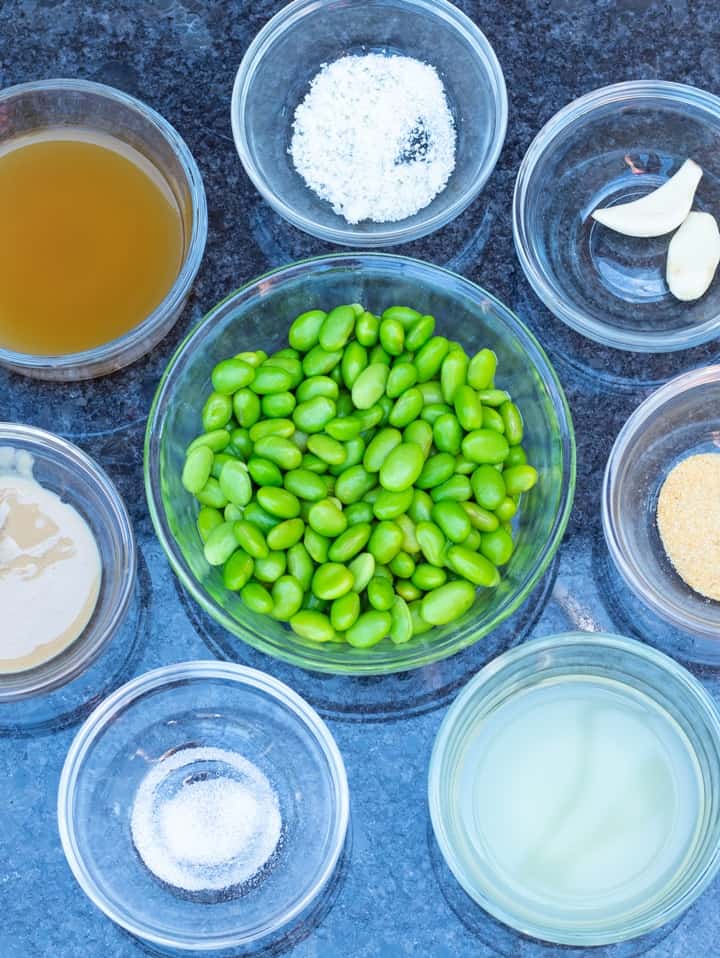
- Edamame- Already shelled varieties can be found in the frozen food section of many grocery stores.
- Garlic- Most hummus recipes use garlic because it adds delicious flavor.
- Tahini– This is just crushed sesame seeds made into a creamy texture.
- Vegetable stock- You can purchase this or make homemade veggie broth from scraps.
- Lemon juice- Hummus requires an acidic flavor, and lemon juice is the most common ingredient for that.
- Seasoning- Garlic powder, onion powder, and salt.
How to make edamame hummus
The recipe card at the bottom of the page has the full list of ingredients with measurements and instructions.

STEP #1: Begin by defrosting the edamame beans. There are a number of different options for doing this such as on the stovetop in boiling water, in a microwave, or by simply running warm water over them.
My favorite method for defrosting is simply to place the beans in a colander and run very warm water over them. It takes only a couple of minutes, and the beans are ready to be used.
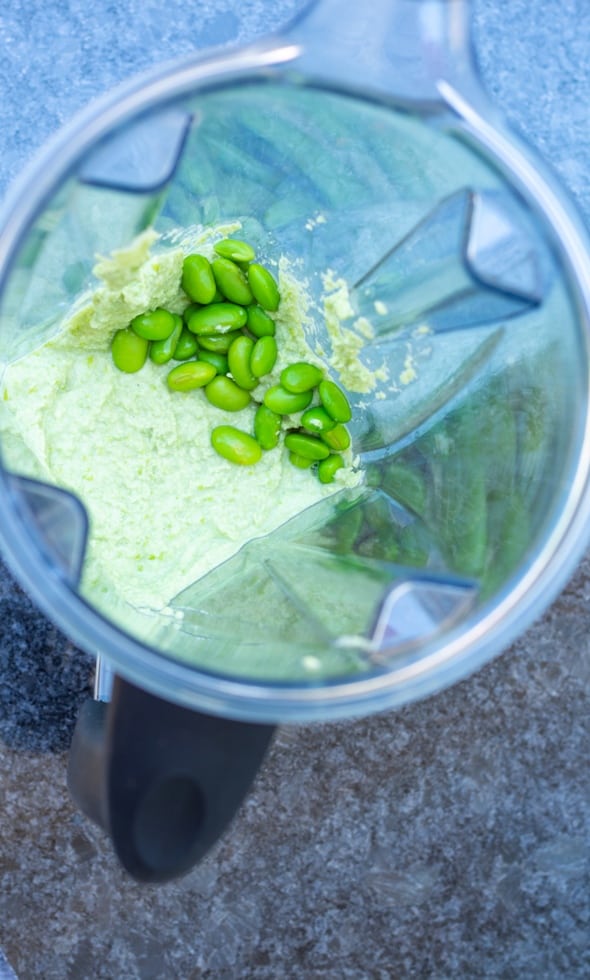
STEP #2: Next, place all the ingredients–beans, tahini, lemon juice, garlic, salt, onion & garlic powder, water, and herbs–in a food processor or blender. Process the ingredients for about 1-2 minutes, pausing to scrape down the sides of the container as needed. Blend until the mixture is blended well and to the consistency desired. If needed, add more water 1 tablespoon at a time to thin out.
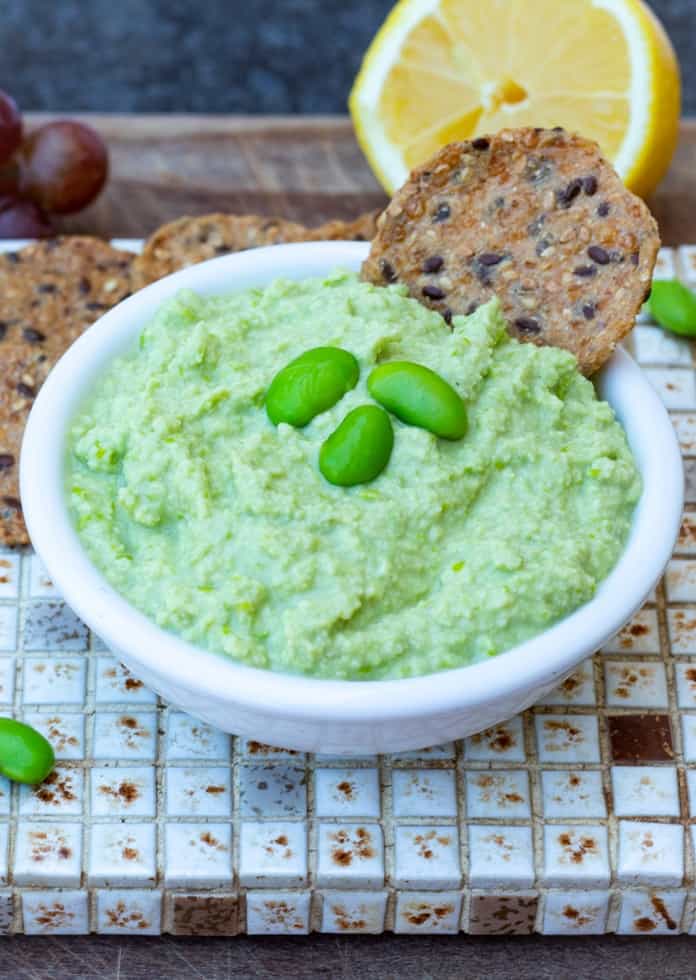
STEP #3: Taste and, if needed, add a little extra salt to get that perfect flavor. Serve as a dip with carrot and celery sticks, and slices of cucumber. Other great serving options are on a sandwich or crusty bread. If you haven’t tried our hummus veggie sandwich, that needs to change right now!
Storage & Freezing
This hummus lasts approximately 7-10 days in a tightly sealed container in the refrigerator.
Hummus even freezes well in an airtight container for up to 6-8 months. The day before you want to eat it, move the hummus container from the freezer to the refrigerator. It takes at least a few hours to thaw until it’s ready to eat. Thawing can take longer depending on how much is in your container.
It’s best to freeze hummus in small portions to make defrosting quicker and to have handy small amounts to eat in one sitting.
Frequently Asked Questions
To achieve a creamy texture in oil-free edamame hummus, blend the ingredients in a high-speed food processor and gradually add water until you reach the desired consistency. Using high-quality tahini also helps enhance creaminess.
Oil-free edamame hummus can be served as a dip with fresh vegetables, whole-grain crackers, or pita bread. It can also be used as a spread for sandwiches and wraps or as a topping for salads and grain bowls.
I don’t recommend leaving out the tahini in this particular recipe because I feel it needs the added flavor. We have other oil-free hummus recipes on this site like this basic garlic vegan hummus and our Italian oil-free hummus that you might try.
Oil-free edamame hummus is lower in calories and fat compared to traditional hummus, making it a healthier option. It is also high in protein, fiber, and essential nutrients, promoting overall health and wellness. We have an article that answers in detail all of the health benefits of hummus.
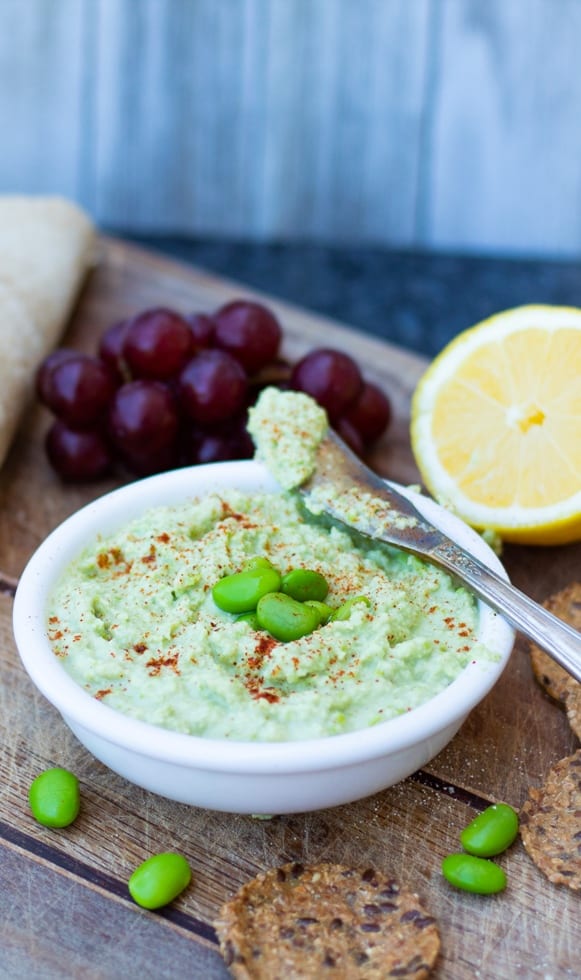
More Favorite Hummus Recipes
If you try this recipe, please let us know how you like it by rating it and leaving a comment. We love to hear from you!
Want to Save This Recipe?
Enter your email & I’ll send it to your inbox. Plus, get great new recipes from me every week!
By submitting this form, you consent to receive emails from EatPlant-Based
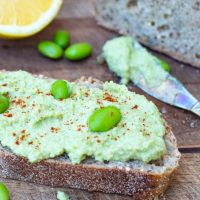
Best Edamame Hummus Recipe
Ingredients
- 1-1/2 cups frozen shelled edamame green soybeans
- 1 tablespoon tahini crushed sesame seeds
- 1/4 cup veggie broth or water
- 1/3 cup lemon juice
- 1 tablespoon garlic clove
- 1 teaspoon garlic powder
- 1 teaspoon onion powder
- 1 pinch of salt adjust to taste preference
- 1 teaspoon smoked paprika for garnish at the end optional
Instructions
- To defrost edamame beans, place them in a colander and run very warm water over them. It takes only a couple of minutes, and the beans are ready to be used.
- Next, place all the ingredients–beans, tahini, lemon juice, garlic, salt, onion & garlic powder, water, and herbs–in a food processor or blender. Save the smoked paprika for topping at the end.
- Process the ingredients for about 1-2 minutes, pausing to scrape down the sides of the container as needed. Blend until the mixture is blended well and to the consistency desired. If needed, add more veggie broth 1 tablespoon at a time to thin out.
- Taste and, if needed, add a little extra salt to get that perfect flavor. Serve as a dip with carrot and celery sticks, and slices of cucumber. Other great serving options are on a sandwich or crusty bread. If you haven't tried our hummus veggie sandwich, that needs to change right now!
Video
Notes
- Texture: To achieve a creamy texture in oil-free edamame hummus, blend the ingredients in a high-speed food processor and gradually add water until you reach the desired consistency. Using high-quality tahini also helps enhance creaminess.
- Tahini: I don’t recommend leaving out the tahini in this particular recipe because I feel it needs the added flavor. We have other oil-free hummus recipes on this site like this basic garlic vegan hummus and our Italian oil-free hummus that you might try.
- Storage: This hummus lasts approximately 7-10 days in a tightly sealed container in the refrigerator. Hummus even freezes well in an airtight container for up to 6-8 months. It’s best to freeze hummus in small portions to make defrosting quicker and to have handy small amounts to eat in one sitting.
Nutrition
Disclaimer
To obtain the most accurate representation of the nutritional information in a given recipe, you should calculate the nutritional information with the actual ingredients used in your recipe, using your preferred nutrition calculator. You are solely responsible for ensuring that any nutritional information provided is accurate, complete, and useful.
About Terri Edwards
Hi guys! I am the content creator behind EatPlant-Based and a licensed Food for Life instructor with the Physicians Committee for Responsible Medicine. I am passionate about sharing healthy recipes and tips to empower others to get healthy. I’m so glad you’re here! Read More…

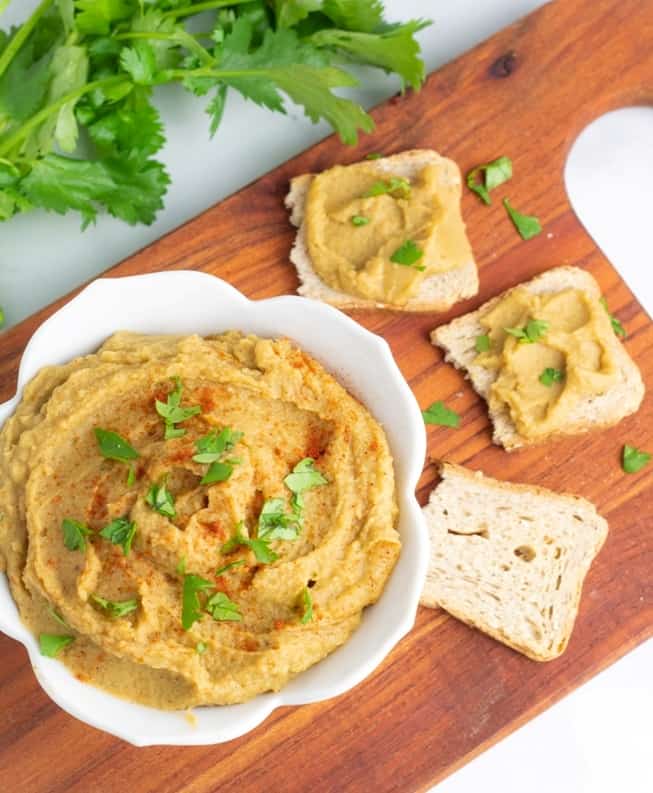
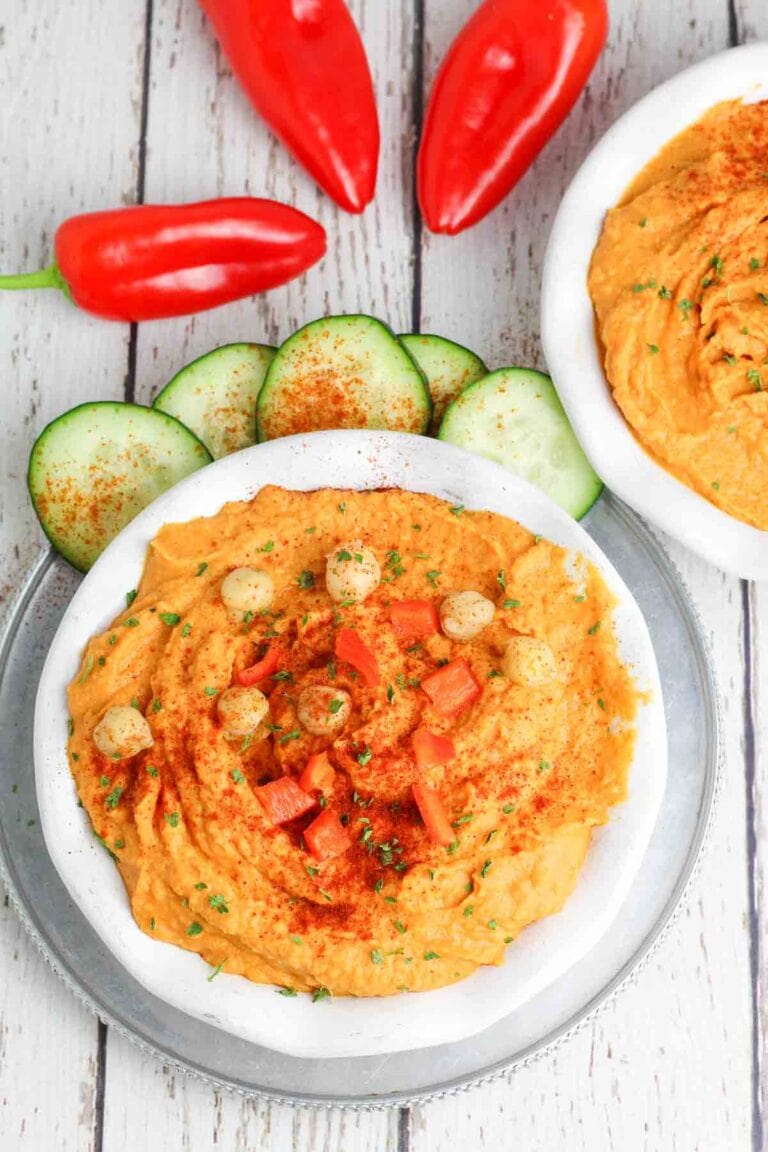
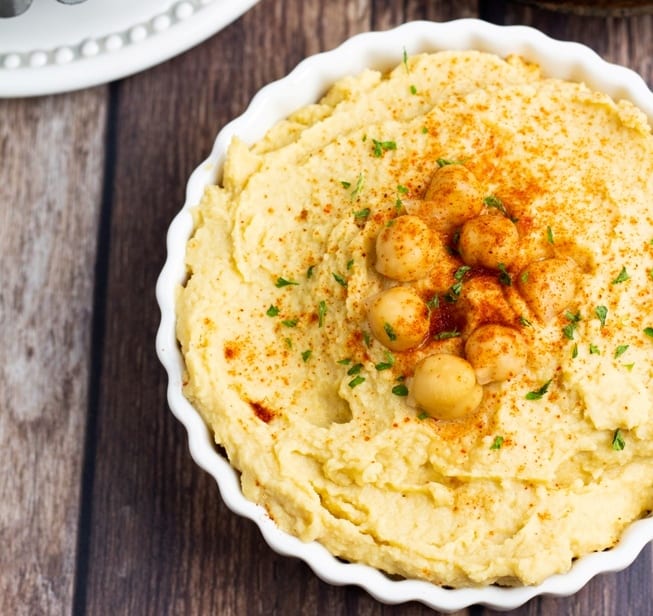
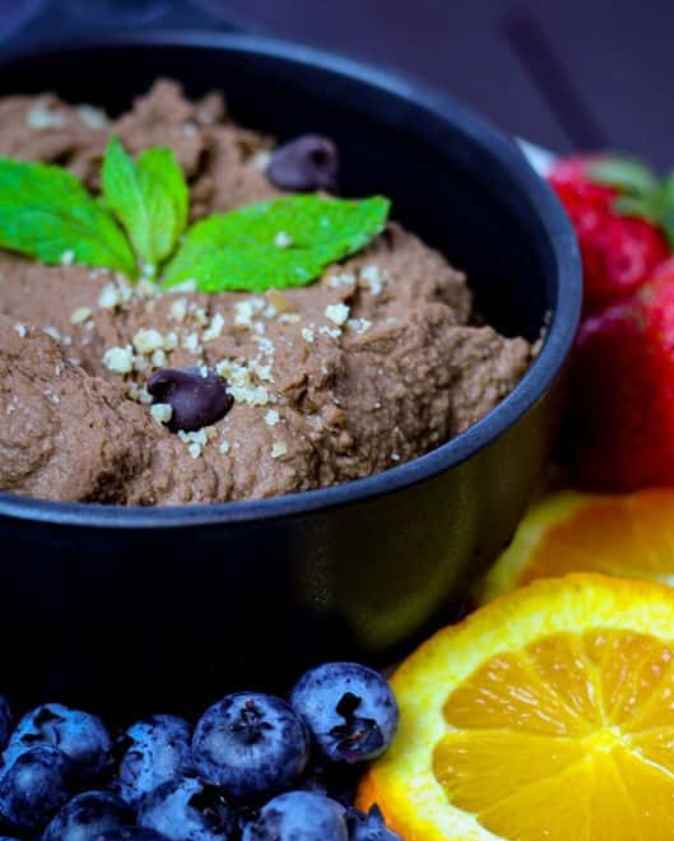

super yummy!!!thanks to this recipe